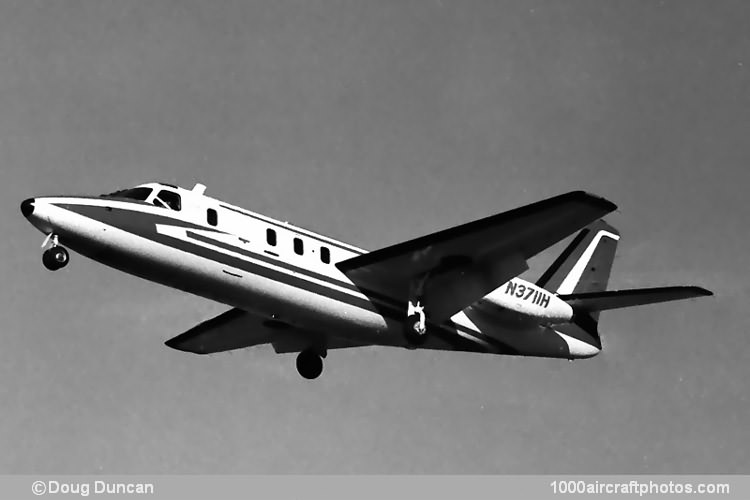The Model 1121 had a straight, tapered, mid-set wing positioned at the rear of the cabin section, a cruciform tail and two 2,850 lb (1,293 kg) st General Electric CJ610-1 turbojets mounted on the rear fuselage. After a mockup had been shown in the summer of 1961, the first prototype of the Jet Commander was flown on January 27, 1963 and the definitive version with a 2.5 in (6 cm) fuselage stretch received its type certificate (A2SW) on November 4, 1964 and went into production at Bethany, Oklahoma.
In 1967 Rockwell and North American Aviation were merged. This prompted a review by the US Justice Department under anti-trust legislation which ruled that Rockwell was in an unduly dominant position in the business jet market through ownership of both the Jet Commander and the Sabreliner - and one of the designs should be terminated. Rockwell decided to sell the Jet Commander in view of the long-term military support commitment posed by the T-39A Sabreliner and, in 1967, the whole Model 1121 production line was offered as a going concern.
The only serious potential acquirer was Israel Aircraft Industries Ltd., originally formed in 1952, which was active in aircraft overhaul and repair and had built Slingsby sailplanes and a large batch of Fouga Magisters for the Israeli AF. They had also done design studies on the Bedek B.101 business jet - but had abandoned this project.
Israel Aircraft Industries (IAI) acquired the Jet Commander in September, 1967 and production commenced at Lod, Israel in mid-1968 once the necessary tools and jigs had been installed. At this point, Aero Commander/Rockwell had completed some 150 airframes (c/n 1 to 150) including the prototype and a static test airframe, eleven Model 1121As with better wheels and brakes, modified fuel system and upgraded interior, and 19 Model 1121Bs with 2,950 lb (1,338 kg) st CJ610-5 engines, and stronger landing gear. Some of the Model 1121Bs were completed as Commodore Jets by IAI to start the new production line.
IAI developed an updated version of the Jet Commander designated Model 1123 Westwind with a longer fuselage, more powerful 3,100 lb (1,406 kg) st CJ610-5 engines, wing tip fuel tanks, a larger stabilizer and wing modifications to improve slow-speed performance. Two Jet Commanders were used as Model 1123 prototypes and the first of 36 Westwinds, registered 4X-COJ (c/n 29), flew September 28, 1970. First delivery took place in September, 1972, and production ran from c/n 151 to 186.
Next built were forty (c/n 187 to 236) of the Model 1124 Westwind I, the Model 1123 fitted with 3,700 lb (1,678 kg) st Garrett TFE731-3-1G turbofans. The 1124 was later fitted with additional internal fuel capacity and known as the Westwind 1 (116 built) - and was supplemented by the even longer range Model 1124A Westwind II (90 built) which used a new "Sigma" wing section. The latter first flew April 24, 1979, registered 4X-CMK (c/n 239) and was distinguished by the winglets fitted to the tip tanks. Both Westwind I and Westwind II models were included in the same serial number sequence - which ran from c/n 237 to 442.
The pictured aircraft was built in 1967 and, as follows, had a lot of identities and owners:
|
N4690E: |
Owner unknown |
